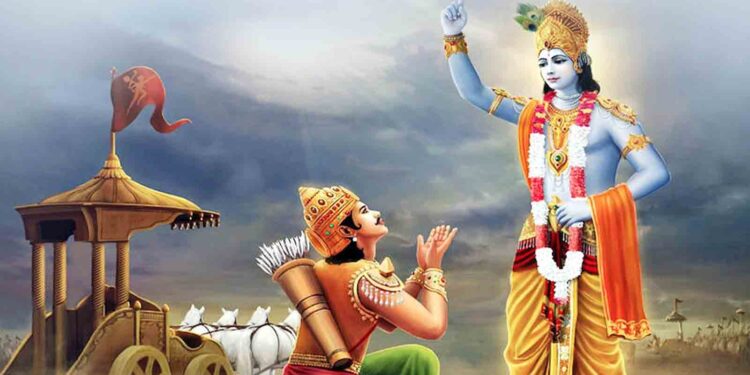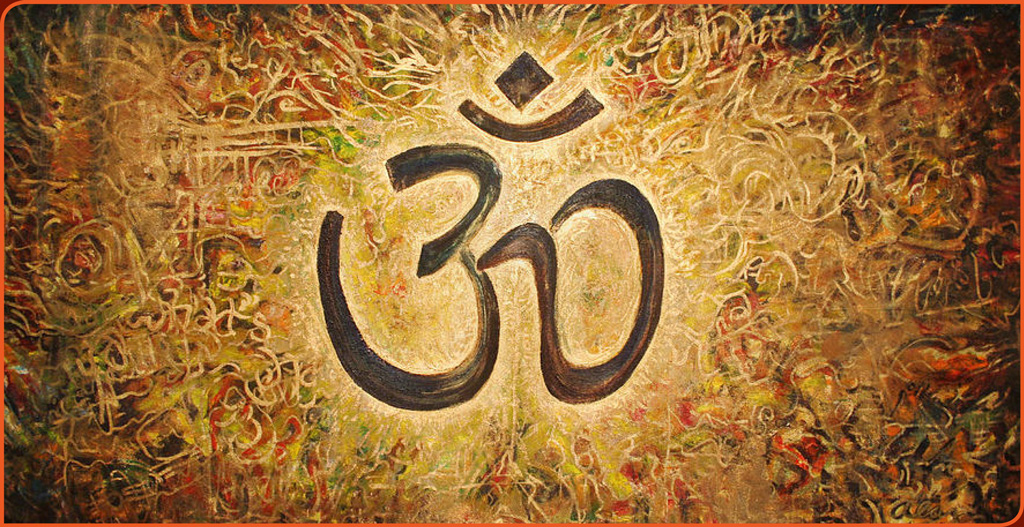Recap
Chapter 1 is Vishaad Yog, and Chapter 2 is Sankhya Yog. We completed that last time. But before we start Chapter 3, we need to go over the key points in the previous chapters, because that is the foundation.
Let us share the summary if Chapter 1and Chapter 2. Chapter 2 is the key, if you understand this, you will understand all the others better.
In Chapter 1, Arjun was confused and depressed -Vishaad. He saw his family in front of him, he didn’t want to fight them. This caused him to be depressed and confused. The cause of Vishaad or confusion was because of Moh – attachment. He was attached to his grandfather, his Guru, his personal desire.
Chapter 2 talks about Sankhya Yog. If you meet someone who is a college graduate, will you ask him if he went to elementary school? No, because you take for granted that he went through all the grades. Similarly, Chapter 2 is like primary school. Unless you learn this well, you will not be able to go forward.
Chapter 2 has four main teachings. The key words here are Shraddha, Gyan, Karma, and Sthita Pragya. These are the foundational teachings.
1st teaching: Shraddha: Commitment, Trust in teaching, surrender seeking shelter or guidance to show Arjun the path, which is Shreyas, or good for all.
2nd teaching: Gyan Yog: the foundational knowledge. What is my Swadharma? My personal duty? The main teaching is that you are not the body, you are the Atman. When you realize this, that is Gyan – self-realization.
3rd teaching: Karma Yog or Buddhi Yog. You should have Samatwam – evenness of mind when doing the karma (action). This is your duty, not your privilege. When doing the action, you should not think about the Karmaphal (results of your actions).
4th teaching: Sthita Pragya – one who has steady wisdom. Such a person gives up all Adharmic or illegitimate desires, like greed. He has Santosh, which means that he is satisfied in the Self by the Self. He is free from attachment to material possessions, free from anger resulting from unfulfillment. These are the qualities of a true Yogi.
Shraddha, Gyan and Karma help me to unite with Bhagwan, which is Satya (truth).
Knowledge Check
Summary of Chapter 1 and 2
Chapter 1 – Arjun Vishād Yoga
- Arjun’s depression and confusion was due to Moh-Attachment.
Chapter 2 – Sānkhya / Gyān Yoga
Section 1: Shraddhā Yoga
- Arjun’s surrender (seeking shelter or guidance): Samarpan or Shraddhā
- Arjun’s Prarthana (prayer) for Shri Krishna’s guidance was to lead him to Shreyas.
Section 2: Gyān Yoga
- Basic or foundational knowledge (Gyān): Deha (Body) and Dehi (Atmā). Know the difference.
- Who am I? I am the Atma.
- What is my identity i.e. What is my Swadharma? One should know this before taking up any Karma/action/task.
Section 3: Karma Yoga or Buddhi Yoga
- Evenness of Buddhi (intellect) during the Karma/action, that is Samatvam.
- Karma is your duty, not a right (privilege).
- Stay away from clinging to Karma-Phal (results).
Section 4: Qualities of a Yogi, a person of Steady wisdom (Stitha-Pragya)
- Gives up all the adharmic (illegitimate) desires such as Greed.
- Always satisfied (Santosh) in the self by the self.
- Free from attachment (Rāg) to material possessions.
- Free from fear (Bhay) of impending failure.
- Free from anger (Krodh) resulting from unfulfillment.
Shraddhā, Gyan and Karma help me unite with Bhagwan (who is Satya), and that is called Yoga.
Chapter 3: Karma Yog
In this chapter Bhagwan goes into more detail about Karma Yog. All action is karma. But when Bhagwan is talking about karma, he means the prescribed action. Suppose you have a headache, you go to the doctor, and he prescribes some medicine for your headache. You have to take the correct medicine for what you have. If you have a headache, you will not take medicine for your stomach. Just like that, even though all action may be karma, the correct action is Karma, the prescribed action.
Shloke 1:
arjun uvācha
jyāyasī chet karmaṇas te matā buddhir janārdana
tat kiṁ karmaṇi ghore māṁ niyojayasi keśhava
vyāmiśhreṇeva vākyena buddhiṁ mohayasīva me
tad ekaṁ vada niśhchitya yena śhreyo ’ham āpnuyām
Arjun says: Krishna, if you consider Knowledge as superior to Action, why do you urge me to do this dreadful action, Keshav?
If Gyan is important, why are you forcing me to do this action?
Arjun is talking about War, which is the action. But Arjun does not want any part of this action, he wants to run away.
Bhagwan says: all three things are needed to be with Bhagwan: Shraddha, Gyan, and Karma.
Arjun is confused, he does not think he needs all three. He needs to think about it for a long time. Just like you eat chewing gum, you chew it for a long time and enjoy it slowly. Just like that, you think about it during the day.
A father took his son to a swimming pool to teach him how to swim, but the child was afraid of the water. When father tried to encourage the boy to get into the pool, the boy said that he could get into the pool if there was no water in the pool.
But if you want to swim, you have to get into the water. You may have the theoretical knowledge of how to swim, but that is not enough for you to learn how to swim. You have to get into the water to learn how to swim.
Knowing about Yog is not enough, you have to know all three things: shraddha, gyan, and karma.
Bhagwan answers his question in Shloke 3:
loke ’smin dvi-vidhā niṣhṭhā purā proktā mayānagha
jñāna-yogena sāṅkhyānāṁ karma-yogena yoginām
Arjun, in this world two courses of Sadhana (spiritual discipline) had been enunciated by me in the past. In the case of the Sankhyayogi, the Sadhana proceeds along the path of knowledge, whereas in the case of the Karmayogi, it proceeds along the path of action.
Bhagwan says there are two paths to reach fulfillment in life, the path of karma (action) and the path of gyan (knowledge). They are not different, they go together. For example, there are two tracks in the railway line which are parallel. The train needs both tracks to travel, it goes on them simultaneously. Similarly, the path of gyan and karma go together, they go in parallel.
The first path is Gyan -learn, listen, meditate, and see where it fits into my life. The biggest gyan is that I am the Atma. Am I using that knowledge in my life? If I am not using it, I am not digesting that teaching. Whatever I am learning is not being transformed into the Awareness.
The second path is karma – action based on evenness of buddhi that is balanced. My intellect should always be balanced. When faced with two reasonably good choices, I should be able to make the right choice.
The purpose of both these paths is to know yourself and to be happy. Both Karma and Gyan are important. Karma or Action is valuable when guided by Gyan or knowledge.
If you use karma in isolation, it has no meaning. If gyan is present alone, it has no meaning. Both need to be together. Action is valuable only when guided by knowledge.
Shloke 9:
yajñārthāt karmaṇo ’nyatra loko ’yaṁ karma-bandhanaḥ
tad-arthaṁ karma kaunteya mukta-saṅgaḥ samāchara
Man alone is bound by his own action except for when it is performed for the sake of sacrifice. Therefore, Arjun, do you efficiently perform your duty, free from attachment, for the sake of sacrifice alone.
There is a word here, Yagna. Yagna means sacrifice. When we do a yagna, we think of it as praying while performing a fire ritual. We put herbs, samagri, ghee etc. into the fire. You put all your efforts into the fire. You sacrifice your time and effort. You are doing it without any expectation of return.
Sacrifice is doing something without any selfish thought or motive behind it. When we do an action for others with joy, that does not bind us. In such a case there is no attachment. The action I do just for myself binds me, it is a selfish action, so there is attachment, and this leads to desire. Nobody can guarantee that all desires will be fulfilled. When there are unfulfilled desires, that leads to anger, agitation, which in turn leads to distortion and loss of memory.
In Bhagwad Geeta, Bhagwan says all Karma is yagna. When you do an action, it is a yagna. But not just any action is yagna. When you put all your thought process, your actions, your efforts into the action, it becomes yagna. So Geeta says Karma is a Yagna. It purifies the mind. But you should do it without any attachment to the results of the action, as we saw in Chapter 2.
There is always a result of any action, but it may or may not be in your favor. When you focus on the result, it makes you anxious, your breathing changes, and you lose focus. When you focus on the action as it is, the anxiety disappears. When you perform the action with the focus that I will accept whatever comes, your action becomes a Yagna, and that is called Karma Yog.
There is a word in Sanskrit called Tyaag. That also means sacrifice. When you do something that is not just for yourself but for the good of others (Shreyas) without expecting anything in return, that is Tyaag. If you perform an action not due to selfish reasons but for the good of others, your action becomes a sacrifice, it becomes Tyaag. All actions performed with Tyaag become Karma Yog.
From a series of talks by Sanjay Mehta, transcribed and compiled by Jaya Asthana.




![[ India Today ] Ohio senator JD Vance thanks wife, a Hindu, for helping him find Christian faith](https://hinduvishwa.org/wp-content/uploads/2024/06/us-senator-jd-vance-reveals-how-his-hindu-wife-usha-helped-him-find-his-christian-faith-image-re-272530504-16x9_0-120x86.webp)









